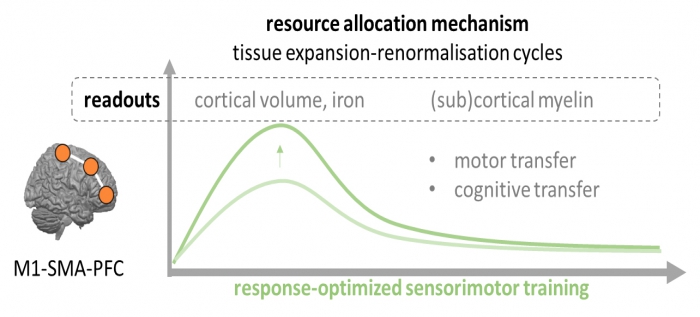C01 - Dynamic modelling of training-induced, response-optimised mobilisation of neural resources
Improvements in cognition during ageing require neural resource mobilisation through effective training interventions. We hypothesise that neural resource mobilisation can be optimised by adapting the task demands relative to the current ability. We refer to the gap between demand and ability as the Ability Prediction Error (APE). Using computational modelling and longitudinal quantitative MRI (qMRI), we aim to explore how APEs control sensorimotor performance improvements, behavioural transfer and neural resource mobilisation at macro- and mesoscopic brain levels in a defined (pre-) frontal brain circuit. This project develops a computational brain-behavioural model for frontal neurocognitive circuit reorganisation serving performance improvements to match demands of a novel task. We assess brain changes during training that (a) differentiate deeper layers and cortex-adjacent white matter and (b) integrate macro- and multiple (micro-) structural imaging modalities (MT, R2* & DTI/NODDI). We study a CRC cohort (Z03-Maass/Kreißl/Düzel) subsample of 60 older participants’ learning trajectories using dynamical system modelling and hierarchical Bayesian inference. We hypothesise that experimentally manipulated APEs predict specific brain-behavioural adaptations. The dynamical model parameters represent (1) the ‘update rules’ (or dynamics) of week-wise individual performance and the (2) ‘microstructural cortical updates’ underlying these performance improvements during learning. Each participant acquiring the sensorimotor ability has an initial brain-behavioural starting point (a given raw ability/resource), adapts according to mechanisms via manipulated APEs and ends at a final state reflecting individual limitations of plasticity.

Conceptual framework of the project:
Transient (expansion-renormalisation) time course of brain plasticity as proposed neural resource mechanism. Readouts include brain tissue property changes in a neurocognitive circuit of M1, SMA and PFC and behavioural performances in near motor and far cognitive transfer tests.






